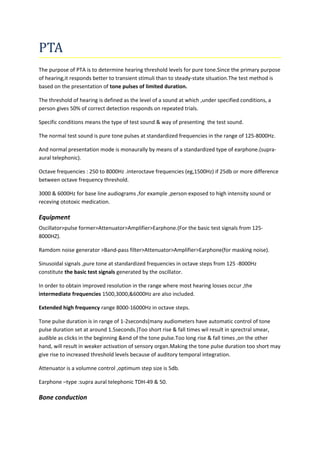
Pta(sbo 3)
- 1. PTA The purpose of PTA is to determine hearing threshold levels for pure tone.Since the primary purpose of hearing,it responds better to transient stimuli than to steady-state situation.The test method is based on the presentation of tone pulses of limited duration. The threshold of hearing is defined as the level of a sound at which ,under specified conditions, a person gives 50% of correct detection responds on repeated trials. Specific conditions means the type of test sound & way of presenting the test sound. The normal test sound is pure tone pulses at standardized frequencies in the range of 125-8000Hz. And normal presentation mode is monaurally by means of a standardized type of earphone.(supra-aural telephonic). Octave frequencies : 250 to 8000Hz .interoctave frequencies (eg,1500Hz) if 25db or more difference between octave frequency threshold. 3000 & 6000Hz for base line audiograms ,for example ,person exposed to high intensity sound or receving ototoxic medication. Equipment Oscillator>pulse former>Attenuator>Amplifier>Earphone.(For the basic test signals from 125- 8000HZ). Ramdom noise generator >Band-pass filter>Attenuator>Amplifier>Earphone(for masking noise). Sinusoidal signals ,pure tone at standardized frequencies in octave steps from 125 -8000Hz constitute the basic test signals generated by the oscillator. In order to obtain improved resolution in the range where most hearing losses occur ,the intermediate frequencies 1500,3000,&6000Hz are also included. Extended high frequency range 8000-16000Hz in octave steps. Tone pulse duration is in range of 1-2seconds(many audiometers have automatic control of tone pulse duration set at around 1.5seconds.)Too short rise & fall times wil result in sprectral smear, audible as clicks in the beginning &end of the tone pulse.Too long rise & fall times ,on the other hand, will result in weaker activation of sensory organ.Making the tone pulse duration too short may give rise to increased threshold levels because of auditory temporal integration. Attenuator is a volumne control ,optimum step size is 5db. Earphone –type :supra aural telephonic TDH-49 & 50. Bone conduction
- 2. Bone conduction is far more complex.In addition to direct mechanical pathway to the cochlea there are another three routes .a)vibration of the skull give rise to a relative motion of the ossicular chain & middle ear components.b) they also vibrate wall of EAC , particularly outer cartilageous part.When EAC is open,this component is weak but when the EAC is occluded by earphone ,hearing aids,or a ear protector,it become significantly larger.It is so called occlusion effect may increase by 20- 30db in the lower frequency range.c) CSF also provide a pathway for bone conduction by connecting perilymph in the innar ear. Masking noise Noise introduced into nontest ear to prevent that ear from detecting signals intended for test ear. Neceeaary when signal to test ear is strong enough to vibrate skull &travel to nontest ear crossover. Reduction of sound energy from one side of the skull to other is interaural attenuation. Interaural attenuation for AC with most supra-aural earphone 40-65db depending on stimulus frequency .over 70db for insert earphone ,for bone conduction 0 to 10db. Crossover in Ac can occur as low as 40dbHL &BC as low as 0 dbHL. For pure tone ,masker is narrow –band noises,for speech stimuli masker is speech –spectrum noise. Insert earphones allow much higher interaural attenuation & thus ,there is much less chance of crossover,interaural attenuation may be 70 to 90db,which often eliminates the need for masking during AC testing. Two rules of when to mask. AC: mask the nontest ear whenever the AC level to test ear exceeds the bone conduction level of the nontest ear by 40db or more for circumaural ear phones.7o db or more for insert earphones. BC: Mask the nontest ear when there is an air-bone gap greater than 10db in the test ear. Test environment Psychoacustic tests require a concentrated undisturbed listerner. Absence of visual & sensory distractions. Acceptable ventilation & sufficiently low ambient sound level, The correct performance of Pure tone audiometers has to be verified at regular intervals. (not exceeding one year). Test method Two alternate methods for the manual determination of hearing thresholds.Ascending method (modified Hughson-westlake method): It is based on repeated ascents from inaudible to just audible stimuli in steps of 5db.As soon as the listener responds,the level is decrease by 10db& new ascent is started.The hearing threshold level is defined as the stimuli level at which the listerner first has given three correct responses after 3 to 5 ascending series of stimuli.
- 3. The first test frequency is 1000Hz followed by higher frequencies&Finally the lower frequencies in falling order. The alternative manual method is bracket method Which is based on alterntive 5db ascending & 5 db descending series. Sources of error Physiological sources;The auditory pathway always have a certain spontaneous activity also in the absence of any audible sound.this activity can be considered as aphysiological noise. Psychological sources: Fatique will of course affect the listener’s ability to concentrate &cooperate. Methodological sources:The presentation of the test tone, their duration ,interval between the successive tones &order of varing the test tone level may affect the test result. Physical /acoustic sources: the placement of the transducer,supra-ear earphone .A leakage usually affects the lowest frequencies.Even relatively small changes in position of the earphone in relation to the canal opening may affect the sound pressure at the ear drum. The placement of bone vibrator on the mastoid process. Ambient sound levels constitute another potential source of error. Correct calibration of the test equipment is obviously important. When describing ahearing loss plotted on an audiogram ,configuration of the loss is important information.the audiogram may be: 1)flat (normal hearing or mixed hearing loss ) 2)Rising (meniere’s disease) 3) Sloping (presbyacusis) 4) Falling type (sharp falling,noise induced hearing loss) 5)notched (otosclerosis) 6)Saucer-shaped/Trough-shaped. (congenital sensorineural)
